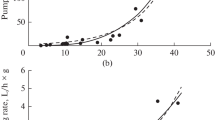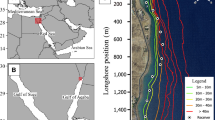Abstract
Studies employing Scuba techniques were carried out on populations of 3 species of tropical demosponges to determine in situ patterns of water-pumping activity. Short-term changes in individual activity of deep-water species (15 to 55 m) were determined from continuous recordings of exhalant current velocities. Long-term changes were determined by repeated measurements of oscular velocity and oscular area. Mycale sp. was found to maintain constant levels of pumping activity in both short and long-term studies. Verongia gigantea underwent periodic cessations of activity averaging 42 min, at random intervals of approximately 19 h. Cessations were asynchronous throughout the population and inherent in origin. Long-term activity variations appeared to be cyclic, but were explainable by environmental events. Shallow-water populations of Tethya crypta exhibited a synchronized diurnal cycle of contraction and dilation, probably tied to the diurnal cycle of illumination. A longer term (average 15.8 days) cycle of activity-inactivity, also involving contraction and dilation, was asynchronous throughout the population during the calm season. Each individual maintained a fairly uniform cyclic period ranging from 9 to 21 days. Changes of T. crypta activity were probably due to changes in flagellar activity. With the onset of the stormy season, the activity of all members of the population was brought into synchrony by the effects of approximately biweekly storms. The behavior of Verongia archeri, Agelas sp., and other species indicates that constant activity (e.g. Mycale sp.) may be restricted to thin-walled species working at low pressures and velocities. Activity patterns are consistent within species, but variable in higher taxa. Behavioral activity patterns of sponges must be taken into account in ecological and physiological studies of these animals.
Similar content being viewed by others
Literature cited
Annandale, N.: Notes on freshwater sponges. VI. The midday siesta of Spongilla in the tropics. Rec. Indian. Mus. 1, 387–392 (1907).
Bagby, R. M.: The fine structure of myocytes in the sponges Microciona prolifera (Ellis and Solander) and Tedania ignis (Duchassaing and Michelotti). J. Morph. 118, 167–182 (1966).
Bergquist, P. R. and W. D. Hartman: Free amino acid patterns and the classification of the Demospongiae. Mar. Biol. 3, 247–268 (1969).
— and J. J. Hogg: Free amino acid patterns in Demospongiae: a biochemical approach to sponge classification. Cah. Biol. mar. 10, 205–220 (1969).
—, M. E. Sinclair and J. J. Hogg: Adaptation to intertidal existence: reproductive cycles and larval behavior in Demospongia. Symp. zool. Soc. Lond. 25, 247–271 (1970).
Bidder, G. P.: The relation of the form of a sponge to its currents. Q. Jl microsc. Sci. 67, 293–323 (1923).
Borojević, R., W. G. Fry, W. C. Jones, C. Lévi, R. Rasmont, M. Sara et J. Vacelet: Mise au point actuelle de la terminologie des éponges (A reassessment of the terminology for sponges). Bull. Mus. natn. Hist. nat., Paris (2e ser.) 39, 1224–1235 (1968).
Brown, F. A., Jr.: Living clocks. Science, N.Y. 130, 1535–1544 (1959).
—, M. F. Bennett, H. M. Webb and C. L. Ralph: Persistent daily, monthly, and 27-day cycles of activity in the oyster and quahog. J. exp. Zool. 131, 235–262 (1956).
—, M. Fingerman, M. I. Sandean and H. M. Webb: Persistent diurnal and tidal rhythm of color change in the fiddler crab Uca pugnax. J. exp. Zool. 123, 29–60 (1953).
—, H. M. Webb, M. F. Bennett and M. I. Sandean: Evidence for exogenous contribution to persistent diurnal and lunar rhythmicity under so-called constant conditions. Biol. Bull. mar. biol. Lab., Woods Hole 109, 238–254 (1955).
Emson, R. H.: The reactions of the sponge Cliona celata to applied stimuli. Comp. Biochem. Physiol. 18, 805–827 (1966).
Finks, R. M.: The evolution and ecologic history of sponges during Palaeozoic times. Symp. zool. Soc. Lond. 25, 3–22 (1970).
Forstner, H. and K. Rützler: Two temperature-compensated thermistor current meters for use in marine ecology. J. mar. Res. 27, 263–271 (1969).
Goreau, T. F. and J. W. Wells: The shallow-water Scleractinia of Jamaica. Revised list of species and their vertical distribution range. Bull. mar. Sci. 17, 442–453 (1967).
Hoyle, G.: Spontaneous squirting of an ascidian Phallusia mammillate Cuvier. J. mar. biol. Ass. U. K. 31, 541–562 (1953).
Hyatt, A.: Revision of the North American Poriferae; with remarks upon foreign species. Part I. Mem. Boston Soc. nat. Hist. 2, 399–408 (875).
Jones, W. C.: Is there a nervous system in sponges? Biol. Rev. 37, 1–50 (1962).
Jørgensen, C. B.: Quantitative aspects of filter feeding in invertebrates. Biol. Rev. 30, 391–454 (1955).
—: Biology of suspension feeding, 357 pp. London: Pergamon Press 1966.
Laubenfels, M. W., de: A discussion of the sponge fauna of the Dy Tortugas in particular and the West Indies in general, with material for a revision of the families and orders of the Porifera. Publs Carnegie Instn 467, 1–225 (1936).
—: Sponges of the Western Bahamas. Am. Mus. Novit. 1431, 1–25 (1949).
Lentz, T. L.: Histochemical localization of neurohumors in a sponge. J. exp. Zool. 162, 171–180 (1966).
Lévi, C. et P. Lévi: Population bacterienne des éponges. J. Microscopie 4, 60 (1965).
Loosanoff, V. L.: Effect of temperature upon shell movements of clams Venus mercenaria (L.). Biol. Bull. mar. biol. Lab., Woods Hole 76, 171–182 (1939).
— and C. A. Nomejko: Feeding of oysters in relation to tidal stages and to periods of light and darkness. Biol. Bull. mar. biol. Lab., Woods Hole 90, 244–264 (1946).
McCammon, H. M.: Filtering currents in brachiopods measured with a thermistor flowmeter. Ocean Sci. Ocean Engng 2, 772–779 (1965).
Parker, G. H.: The reaction of sponges with a consideration of the origin of the nervous system. J. exp. Zool. 8, 3–41 (1910).
—: On the strength of the volume of the water currents produced by sponges. J. exp. Zool. 16, 443–446 (1914).
Passano, L. M. and C. B. McCullough: Coordinating systems and behavior in Hydra. J. exp. Biol. 41, 643–664 (1964).
Pavans de Ceccatty, M.: Les structures cellulaires de type nerveux et de type musculaire de l'éponge siliceuse Tethya lyncurium Lmk. C. r. hebd. Séanc. Acad. Sci., Paris 251, 1818–1819 (1960).
—: Système nerveux et intégration chez les spongiaires. Annls Sci. nat. (Zool. 12e Ser.) 4, 127–137 (1962).
—: Ultrastructures et rapports des cellules mésenchymateuses de type nerveux de l'éponge Tethya lyncurium Lmk. Annls Sci. nat. (Zool.) 8, 577–614 (1966).
Prosser, C. L., T. Nagai and R. A. Nystrom: Oscular contractions in sponges. Comp. Biochem. Physiol. 6, 69–74 (1962).
Rao, K. P.: Tidal rhythmicity and rate of water populsion in Mytilus and its modifiability by transplantation. Biol. Bull. mar. biol. Lab., Woods Hole 106, 353–359 (1954).
Reiswig, H. M.: Porifera: sudden sperm release by tropical Demospongiae. Science, N.Y. 170, 538–539 (1970).
Salánki, J.: Comparative studies on the regulation of the periodic activity in marine lamellibranchs. Comp. Biochem. Physiol. 18, 829–843 (1966).
Vacelet, J.: Les cellules à inclusions de l'éponge cornée Verongia cavernicola Vacelet. J. Microscopie 6, 237–240 (1967).
Warburton, F. E.: The behavior of sponge larvae. Ecology 47, 672–674 (1966).
Wilkins, M. B.: Biological clocks. Advmt Sci., Lond. 24, 273–283 (1968).
Author information
Authors and Affiliations
Additional information
Communicated by J. Bunt, Miami
Rights and permissions
About this article
Cite this article
Reiswig, H.M. In situ pumping activities of tropical Demospongiae. Marine Biology 9, 38–50 (1971). https://doi.org/10.1007/BF00348816
Accepted:
Issue Date:
DOI: https://doi.org/10.1007/BF00348816




